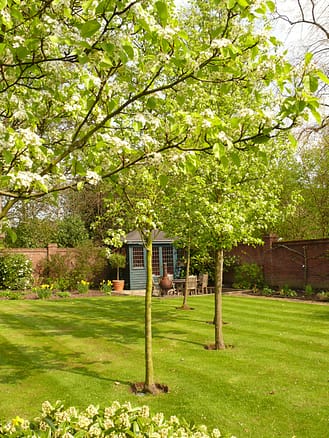Tree selection – why is it so important?

Trees are a natural asset and their benefit to the visual environment can be easily understated. We may think of a typical English countryside view with rolling fields, hedges and specimen Oak trees dotted around. Find out why tree selection is so important below:
But do we ever think of the other benefits trees present to the local fauna and flora?
Trees absorb all sorts of toxins from the air, which is why when you walk around a wood the air always smells and feels that little bit fresher and cleaner. An acre of mature woodland can provide enough oxygen for 18 people and that makes trees pretty important! They also provide significant sources of food and shelter for small woodland animals, birds and insects, all of which are imperative to our ecosystem.
When we pick a tree for a site or our garden, we will want a specimen tree or at least one that will be a real feature as it grows. We should, however, consider a number of things. These include; the size, the spread and height, when and if the tree has visible flowers, the scent, the colour of the leaves in each of the seasons and whether the tree will improve the surrounding environment, perhaps by creating a food source for birds or other small animals.
There are also other types of interest that a tree can bring to its surroundings – bark can be of great interest. Corylus avellana ‘contorta’ has twisted stems and looks great but especially so in the winter when it has no leaves. Whereas, Acer davidii, also known as the “Snake bark Acer”, looks amazing with green and white serpentine stripes on its bark.
Other trees, such as the Tulip tree, Liriodendron tulipifera, is a larger tree which has tulip like flowers when it matures at around the age of 40 years. As can be seen from this tree, sometimes planting a tree is a long-term investment and perhaps even for the benefit of the next generation. This is especially true if you are planting trees that don’t become mature for in excess of 50 years such as the Oak, Beech and Sequoiadendron giganteum that can live for more than 3,000 years!

More commonly found trees suited for planting in a normal sized back garden can include the Amelanchier x grandiflora ‘Ballerina’. This is a pretty specimen tree and well worth the space, with lovely blossom in the spring and bright red foliage as it emerges. It also has small dark purple or black fruits in the autumn, which are edible. Another bonus that this tree brings is the fabulous bright red and yellow colours that the leaves turn in the autumn. A truly great tree for a small garden.
An evergreen tree that is another great choice is the Magnolia grandiflora, a lovely tree which has fabulous white or cream flowers. This tree looks great
and gives additional privacy all year round which is especially important when your garden is overlooked by neighbours!
One final tree we couldn’t not mention is the Davidia involucrata, commonly known as the Handkerchief tree. This is a beautiful tree. Discovered in 1869 and introduced to England in 1904, it has large white bracts that are followed by large oval fruits. If you have the space, a sheltered position and fertile soil this tree will prove to a real spectacle within your garden!
If you need any advice on the choice of trees for your site or garden, and especially so if you want the perfect specimen tree, please do contact us and we will be happy to advise.
ProHort also provide other tree related services, including tree surveys and tree preservation order applications and appeals. Why not get in touch to find out more about how we can help you?
